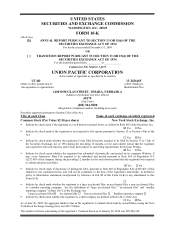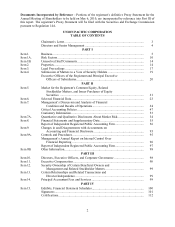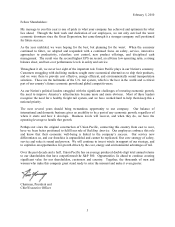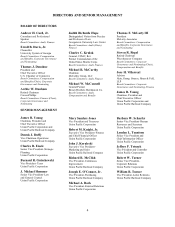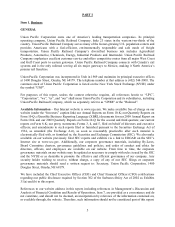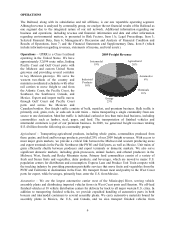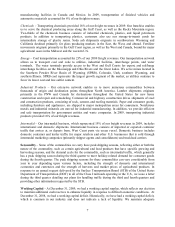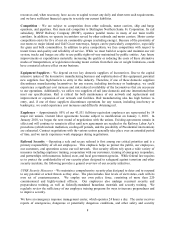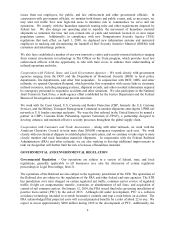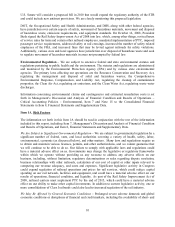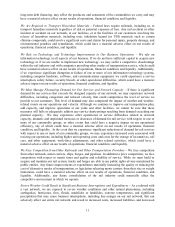Union Pacific 2009 Annual Report Download - page 9
Download and view the complete annual report
Please find page 9 of the 2009 Union Pacific annual report below. You can navigate through the pages in the report by either clicking on the pages listed below, or by using the keyword search tool below to find specific information within the annual report.9
issues from our employees, the public, and law enforcement and other government officials. In
cooperation with government officials, we monitor both threats and public events, and, as necessary, we
may alter rail traffic flow near high-risk areas to minimize risk to communities we serve and our
operations. We comply with the hazardous materials routing rules and other requirements imposed by
federal law. We also design our operating plan to expedite the movement of hazardous material
shipments to minimize the time rail cars remain idle at yards and terminals located in or near major
population centers. Additionally, in compliance with new Transportation Security Agency (TSA)
regulations that took effect on April 1, 2009, we deployed new information systems and instructed
employees in tracking and documenting the handoff of Rail Security Sensitive Material (RSSM) with
customers and interchange partners.
We also have established a number of our own innovative safety and security-oriented initiatives ranging
from various investments in technology to The Officer on the Train program, which provides local law
enforcement officers with the opportunity to ride with train crews to enhance their understanding of
railroad operations and risks.
Cooperation with Federal, State, and Local Government Agencies – We work closely with government
agencies ranging from the DOT and the Department of Homeland Security (DHS) to local police
departments, fire departments, and other first responders. In conjunction with DOT, DHS, and other
railroads, we sponsor Operation Respond, which provides first responders with secure links to electronic
railroad resources, including mapping systems, shipment records, and other essential information required
by emergency personnel to respond to accidents and other situations. We also participate in the National
Joint Terrorism Task Force, a multi-agency effort established by the Justice Department and the Federal
Bureau of Investigation to combat and prevent terrorism.
We work with the Coast Guard, U.S. Customs and Border Protection (CBP, formerly the U.S. Customs
Service), and the Military Transport Management Command to monitor shipments entering the UPRR rail
network at U.S. border crossings and ports. We were the first railroad in the United States to be named a
partner in CBP’ s Customs-Trade Partnership Against Terrorism (C-TPAT), a partnership designed to
develop, enhance, and maintain effective security processes throughout the global supply chain.
Cooperation with Customers and Trade Associations – Along with other railroads, we work with the
American Chemistry Council to train more than 200,000 emergency responders each year. We work
closely with our chemical shippers to establish plant security plans, and we continue to take steps to more
closely monitor and track hazardous materials shipments. In cooperation with the Federal Railroad
Administration (FRA) and other railroads, we are also working to develop additional improvements to
tank car design that will further limit the risk of releases of hazardous materials.
GOVERNMENTAL AND ENVIRONMENTAL REGULATION
Governmental Regulation – Our operations are subject to a variety of federal, state, and local
regulations, generally applicable to all businesses (see also the discussion of certain regulatory
proceedings in Legal Proceedings, Item 3).
The operations of the Railroad are also subject to the regulatory jurisdiction of the STB. The operations of
the Railroad also are subject to the regulations of the FRA and other federal and state agencies. The STB
has jurisdiction over rates charged on certain regulated rail traffic; common carrier service of regulated
traffic; freight car compensation; transfer, extension, or abandonment of rail lines; and acquisition of
control of rail common carriers. On January 12, 2010, the FRA issued final rules governing installation of
positive train control (PTC) by the end of 2015. Although still under development, PTC is a collision
avoidance technology intended to override locomotive controls and stop a train before an accident. The
FRA acknowledged that projected costs will exceed projected benefits by a ratio of about 22 to one. We
expect to invest approximately $200 million during 2010 in the development of PTC. Additionally, the

